October 1 is China’s National Day – scheduled by the founding fathers, Mao & Co., to coincide with China’s traditional Mid-Autumn festival, which falls on the ninth day of the ninth lunar month. In recent years, in an effort to stimulate the economy, the government has decreed a five-day vacation encompassing both holidays. (There’s a catch: offices and schools must stay open the following Saturday and Sunday to make up for lost time!)
We took advantage of the girls’ school holiday to head to the farthest reaches of China’s western province, Xinjiang (SHEEN-JAHNG). We were especially eager to see it because Tom had visited in 1987, and we had read in The New York Times in spring 2004 that Beijing had launched a massive campaign to “modernize” this traditional area, populated mainly by Muslim peoples of various tribes. In recent years, the Chinese government has taken to labeling some of these natives as "terrorists" because they call for a measure of autonomy in their home province - which is officially known, after all, as the "Xinjiang Autonomous Region." Soon after finalizing our travel arrangements, we started seeing all sorts of articles about the region in various US newspapers (click here and here). These articles are worth glancing at before proceeding with our story. |
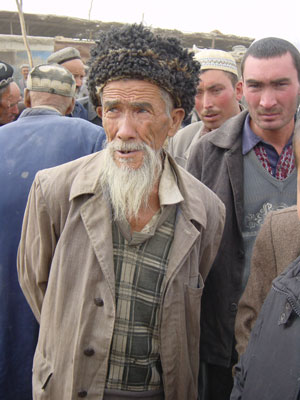 |
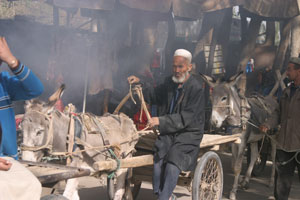 |
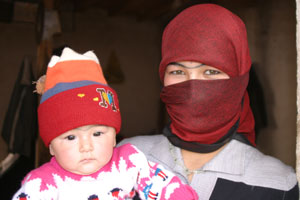 |
 |
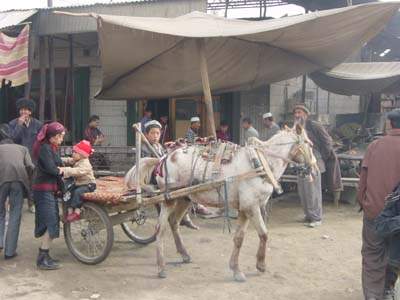 |
Knowing how fast the Chinese modernize, we wanted to experience Xinjiang before it came to resemble every other Chinese province. Once there, we saw ample evidence that we were right not to delay.
| Disembarking after a five-hour flight from Beijing to Xinjiang’s capital city, Urumuqi [Oor-roo-MOO-chee] , we noticed a telling detail: the native Uighur [WEE-gur] peoples might speak their own language, a Turkic tongue written in Arabic script, but Chinese dominates, both in size and every other sense. | 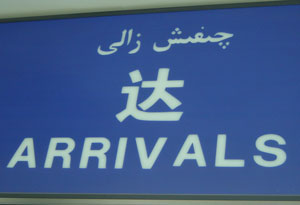 |
Evidence of “Sinification” was everywhere. Entire cities were being rapidly transformed, Chinese-style.
For example, the sidewalks in every Chinese city are laid out with tiles in standard colors, including a bright yellow strip (with distinctive bumps) down the center that helps guide the blind. I'm sure it's hard to miss the irony of installing fancy sidewalks in an area that is still quite poor. The woman on the right is completing construction on a street underpass (another mainstay of traffic-choked Chinese cities), no doubt in anticipation of rapid growth - though in today's Xinjiang, you're more likely to dodge a donkey cart as a car.
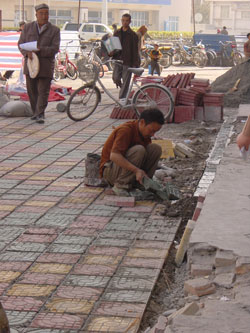 |
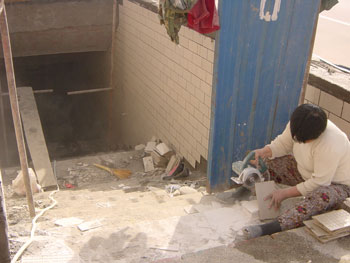 |
Some places have already been modernized beyond recognition, as this picture of the famous Urumqi mosque - you can see the minaret on the right:
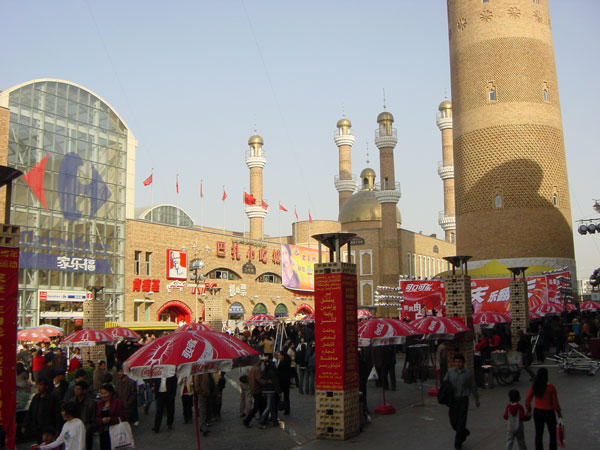
The scene in the square was fit for a movie: Crowds were flooding into the just-opened Carrefours Hypermarket; the Kentucky Fried Chicken was completely full; crowds cheered enthusiastically for the Coca-Cola stage show, in the shadow of the minaret: "Try Coke! It tastes great!" warbled high-energy, ultra-hip Chinese teen girls. The Coke tasting booths were swarming with people grabbing free samples.
Meanwhile, the surrounding stores - formerly booths in an old-fashioned bazaar, but in early 2004 tidily tucked away into a sanitized brick building - offered traditional carpets, exotic spices, and huge souvenir daggers. When the traditional Muslim call to prayer began to blare from the minaret, the Coke tastings and finger-lickin' continued without pause, though most of the men did make their way to the front door of the mosque, with prayer rugs tucked under their arms. Close your eyes and imagine the juxtaposed cacophony of Coke's latest jingle with the sounds of Muslim culture - the sounds of 21st century China.
Next: We explore Urumuqi...